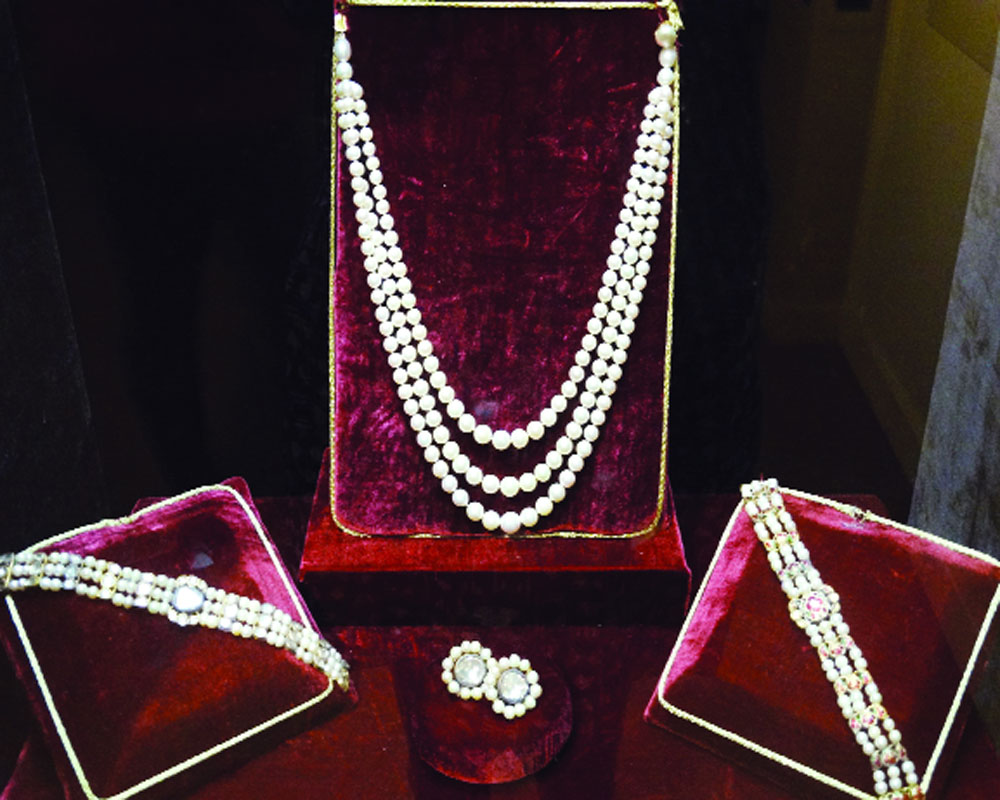The sheer weight of the jewellery and precious stones adorned by the Nizams so nonchalantly might give you a sense of the scale and heft of their wealth, writes Vissa Venkata Sundar
An intimidating high-security prison-like door at the entrance, a dark chamber with discouraging number of security personnel and constantly gazing CCTV cameras over the visitors. As you enter the room, you can’t miss the sense of unusualness of the occasion. Spotlights focused on glass cases displaying some of the most precious gemstones, glittering gold, and sparkling diamonds, and a room filled with babble that would only grow intense while moving from one exhibit to the next. Well, this is the glimpse of the past in all its shimmering glory for you at the Nizams’ jewellery exhibition curated for public display at the National Museum in New Delhi. It is a “never seen before” moment for many visitors gawking at the jewellery and regalia in all its splendour. The sheer weight of the jewellery and precious stones adorned by the erstwhile Nizams so nonchalantly as displayed in the monochromatic photographs will perhaps give you a sense of the scale and heft of their wealth in the yesteryears.
The Nizams were caught in the crosshairs of the geopolitics and made choices that didn’t pay off. And therein lies the intrigue and mystery that dogged their wealth and quandaries. The Asaf Jahi dynasty, familiar to all by the title of its representative, the Nizam, owes its origin to Mir Qamaruddin Chin Qilij Khan, better known as Asaf Jah-I. This dynasty ruled the State of Hyderabad in Deccan for seven generations (1724-1948). It was one of the leading Princely States in India. The area of the dominion was equal in size to Italy. The treasures of Golconda and the Deccan region has been legendary. The Golconda mines were the sole suppliers of diamonds to the world till the beginning of the 18th Century. Many famous diamonds, which adorn the crown jewels across the world, came from these mines. The ‘Orlov’, ‘Darya-I-Noor’, ‘Regent’, ‘Florentine’, ‘Great Mughal’, ‘Nizam’, ‘Sancy’ are a few examples of famous diamonds mined in the Deccan — the dominion of the Nizams. Geographically, the Golconda area for diamond mining stretched to parts of Andhra Pradesh and Karnataka during the 16th-19th Century.
The Nizam and the princes would wear ceremonial regalia to attend official functions. In addition to the sarpench, a turra of gold wire, a distinguished ornament worn only by members of the royal household used to be worn. Princes often wore a smaller sarpench, the turra as well as necklaces, armbands, and belts. Only high-ranking officials would wear turban ornaments. The crown jewels constituted exquisite pieces and large gemstones as head ornaments for the head-dress was an important component of dressing of the princes. Some of the exquisite pieces and large gemstones were used as head ornaments. The sarpench signified power and hierarchy.
The neck would be adorned as the occasion warranted with an assortment of necklaces: A kanthi, a padak marvareed , and finally, a harmurassa (a necklace). The achkan (coat) would have jewelled buttons, a pocket watch in addition to the baglus (belt) on the waist. Important officials and members of the royal household would wear jewelled baglus on formal occasions, ornamented with large gemstones attached to the woven gold belts.
In the early 20th Century, as pocket watches became a fashion statement in Paris and London, the style also caught the eye of Indian royalty and they incorporated it in the ceremonial regalia. The upper arms would be adorned with three armbands, the bhujbands, bazubands, and navaratna bazubands, and the hands would have dastbands (bracelets) and rings.
The Nizams enjoyed heavenly treasures and worldly comforts and pleasures. His Exalted Highness Nawab Sir Mir Osman Ali Khan, who was the last Nizam, is remembered for being the staunchest ally of the British in India. The Nizam made a gift of diamond jewels, including a tiara and necklace, to Queen Elizabeth on the occasion of her marriage and it is still worn by the Queen — the Nizam of Hyderabad necklace.
He refused to submit to the Indian state during the British withdrawal. He finally surrendered to the Indian army in 1948. He was appointed to a ceremonial position of Rajpramukh. The stature of the Nizam reduced in 1956 when his dominion was trifurcated during the reorganisation of Indian States on a linguistic basis. The Nizam then took retirement with three wives, 42 concubines, 200 children, 300 servants, and aging retainers, including a private army, according to an estimate. Apparently, he provided pension to around 10,000 dependents of his former empire.
After his death in 1967, the progeny feud started. The descendants claimed their share and wanted to sell jewellery to international bidders. However, the Government of India intervened and termed it a national treasure. After two decades of negotiations, a deal was struck, and the Government of India acquired the collection in 1995 after paying the descendants. The jewels include the mindboggling 185-carat Jacob diamond that the Nizam apparently used as a paperweight. In today’s world, some estimates suggest the jewellery is worth Rs 50,000 crore.
Our uncaring attitude towards the country’s legendary wealth is troubling. With so many treasures lying unaccounted for in various trusts, temples, and mutts, it is important to systematically list the countries enormous heritage, jewellery traditions, craftsmanship, design, aesthetics, and safeguard them for the coming generations to relish for posterity.
The writer is a communications consultant, travel writer, and a heritage geek


























